In case you hadn’t heard, bees are kind of awesome. They help us grow healthy food, they help plants thrive so they can keep the air pure and clean, and they make honey. In fact, the planet actually needs bees to keep everything running smoothly.
So, if you’re not particularly familiar with bee gardens or pollinator gardens, you might want to check out our in-depth articles that tell us what bee gardens are and how bee gardens help bees.
For those who know and are ready to get creating, the following article should give you all the know-how you need to plant a bee garden.
What You Need to Grow Your Bee Garden
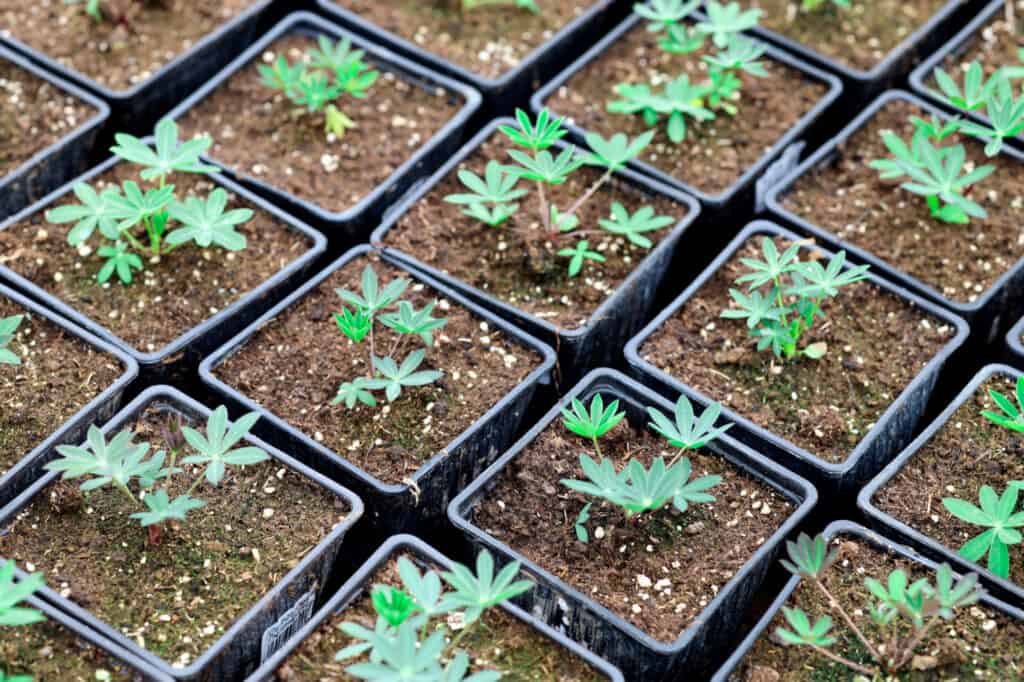
You can start with seeds, seedlings, or established plants.
©VeIrina/Shutterstock.com
Before you get started, it’s a great idea to have all your tools and supplies gathered and ready to go. Some things will be done in stages, of course, but having things gathered will help.
- Curated seeds, seedlings, or plants for your bee garden (more below on this)
- Compost
- Gardening tools, including rake, shovel, hoe, trowel, hand cultivator
- Gardening gloves
- Organic fertilizer
- Bee bath supplies (shallow bowl or container, expanding clay, or small rocks)
- Watering can or soft flow hose nozzle
- Rain barrel (optional)
- Edging material (optional)
- Containers or raised beds (optional)
- Shade cloth, screen, or outdoor curtains (as needed)
The Basics Steps for Creating a Bee Garden
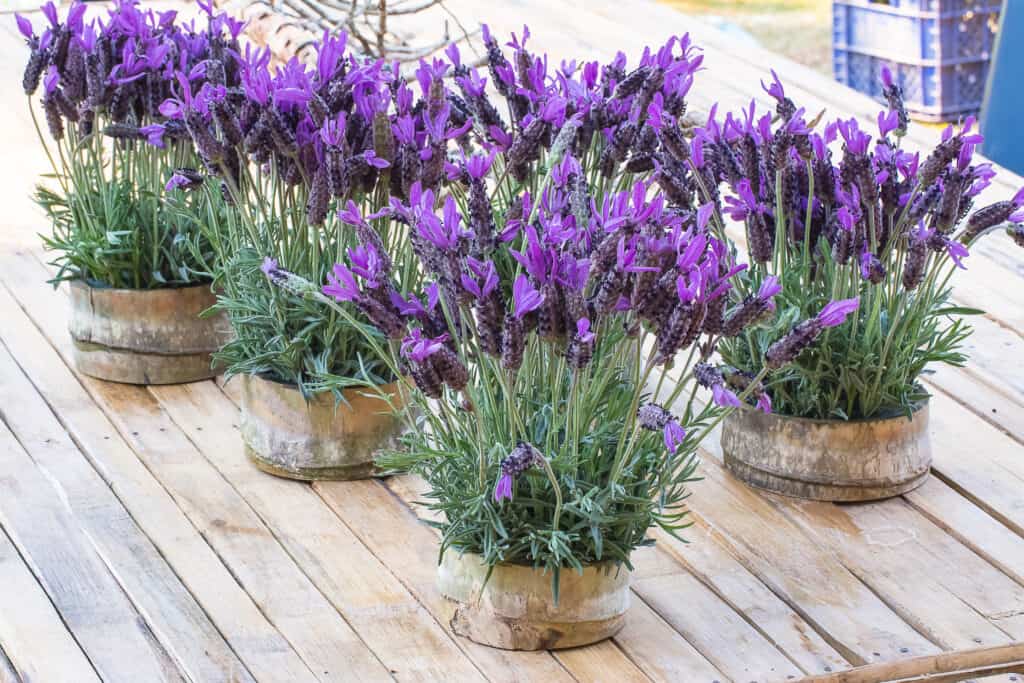
Lavender plants are popular among bees.
©Shan 16899/Shutterstock.com
- Choose the most bee-friendly locations possible within your space.
- Plan your garden with the right plants.
- Build and place the right attractions.
- Plant your bee garden plants along with companion plants.
- Add in some companion plants.
- Introduce helpful insects.
- Avoid chemicals like those found in pesticides and fungicides.
- Provide bees with nesting and sheltering spaces.
- Water your plants properly.
- Use compost and organic fertilizers only.
- Avoid cleaning your garden too thoroughly or too early.
Notes on Bee Garden Creation
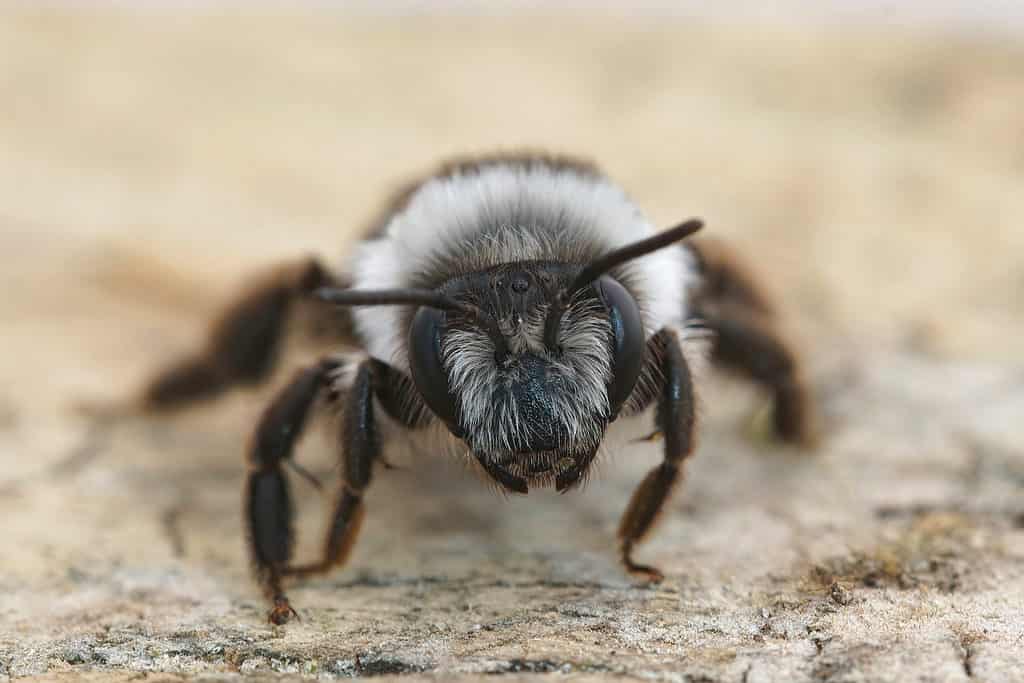
The bee species will vary by your region.
©HWall/Shutterstock.com
It should be noted that building a bee garden does not mean that you have to uproot and discard an existing garden. If you already have plants or a container garden, even, you can easily develop this space into a bee garden by applying the principles in this garden, adding in the right plants, nesting areas, etc.
If you’re converting an existing lawn into your bee garden, be sure to remove current plant cover and grasses, turn the soil, and loosen it well before planting.
And if you happen to live in a drier climate, you can very well create a xeriscape bee garden. There are many plants that thrive natively in these areas that attract bees and other pollinators.
Plan Your Garden

Many species of bees thrive in bright, direct light.
©Gerrit Lammers/Shutterstock.com
You can plan your garden either before or after you gather supplies. But this step is a critical one for the success of your bee garden.
It’s important to note that anyone with any outdoor space at all can build a bee garden. You can go with traditional flower beds or raised beds or plant a fully container-based bee garden.
1. Choose the Best Location
First, you’ll want to select the prime location in your space for growing the pollinator garden plants.
You’ll need a mix of sunny spots and partial shade spots, depending on the plants you choose for the garden. The spot also needs to have some shelter from the wind to protect the plants, though bees, in most cases, don’t generally care that much about wind protection unless in exceptionally windy areas.
If you have limited space that has poor light protection at the hottest time of the day, you can plan on using shade cloths, shade screens, or even some outdoor curtains. That means balconies, patios, porches, and similar may make excellent locations, assuming the plants will receive enough sun for the plant species’ needs to be met.
2. Choose the Right Plants
We go into much greater detail in the plants for bee gardens article but the gist of this:
- Choose native plants for your area.
- Plant blue, white, yellow, or purple flowers.
- Have a variety of plants that have different flower shapes, sizes, and colors.
- Skip hybrid plant species as many are sterile and don’t produce the pollen bees are looking for.
- Choose fragrant species to attract bees.
The variety is particularly important because different bee species have different needs, specifically due to tongue length.
For long-tongued bees, “deep” flowers such as gladiolus and foxglove are great choices. For short-tongued bees, plants with shallow centers like coneflowers and cosmos are great options.
3. Choose and Build the Right Attractions
Additionally, bees need a few things to truly encourage them to stick around your bee garden.
- They need nesting spaces (see below) to protect them from the elements and provide them resting grounds.
- Bees also need a water source. This should be a shallow bowl or dish with some rocks or expanding clay for resting out of the water.
Plant Your Garden
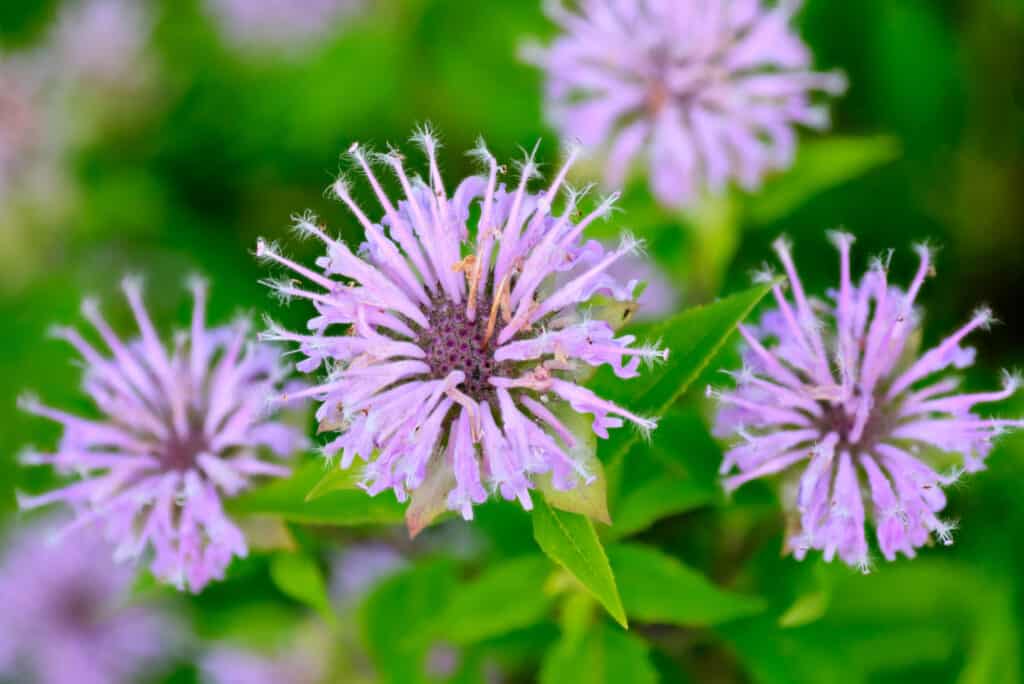
Bee balm attracts many pollinators.
©damann/Shutterstock.com
Once you’ve planned your garden and gathered your supplies, you’re ready to start planting those colorful, native plants.
You may decide between seeds, seedlings, or established plants, based on your own preferences and needs. If you go with established plants, though, be sure to get healthy plants that are already growing well. Often this means going to a local nursery or garden center rather than big box stores. Be sure to wait for the right season to plant the given seeds or plants in the ground or pots outdoors.
4. Grow Like Plants Together
Next, you’re ready to plant your bee attractor plants.
It’s important to note that despite being insects, bees actually don’t have the greatest vision. So, ideally, you’ll plant your bee attractors closely together in clusters. They’re far more likely to be drawn to a bunch of purple flowers than a single yellow blossom isolated on a windowsill.
Ideally, plant several of each plant you’re growing, bunched together, either in the same large container or raised bed or in a set section of the garden. But don’t keep to just one type of plant in your bee garden. Bees love variety – and the more variety you’re able to create, the larger variety of bee species you’ll attract.
As a bonus, the right pollinator garden plants will also draw in butterflies, hummingbirds, and other pollinators that add some excitement to the garden space.
5. Add in Companion Plants

The English cucumber plant is a great companion for bee gardens.
©Siam SK/Shutterstock.com
There are many natural deterrents for pests of many types. Certain plants, for example, draw in helpful insects and keep away pests. Marigolds, for example, are a great draw for many useful insects while discouraging animals and damaging insects like spiders from entering your bee garden. These plants are known as companion plants. They help attract pollinators while driving out harmful pests.
Some other great companion plants are:
- Dill
- Basil
- Borage
- Castor beans
- Celery
- Coriander
- Cucumber
- Geranium
- Onions
- Chives
- Cosmos
- Fennel
- Nasturtium
- Oregano
- Rosemary
- Rue
And if you didn’t notice, a lot of the best companion plants also provide you with some tasty herbs and vegetables to add to your culinary adventures.
6. Add Some Natural Deterrents
You can introduce helpful insects like ladybugs and lacewings. These keep away mealy bugs, aphids, and others that like to kill plants. You can purchase both of these insects – and others – from your local garden center.
7. Skip All Chemicals – Insecticides, Pesticides, Fungicides, Others
As noted above, most gardens, if not all, will have pests try to creep in. Using natural deterrents such as companion plants and helpful insects is the best and healthiest way to prevent pest infestations.
However, occasionally, you may have some infestations you can’t best with companions. In this case, avoid using chemicals, but rather use natural solutions to keep your plants healthy and prevent poisoning those precious bees flying in.
- Diatomaceous earth is a natural pesticide.
- Neem oil is another natural pesticide. You can make your own or purchase some from a trustworthy source online or in garden centers and nurseries.
- Some organic pesticides are safe for bees. Note that they are organic, though, meaning no harmful chemicals are involved. This is key for the safety of the buzzing insects.
8. Build Sheltering and Nesting Areas
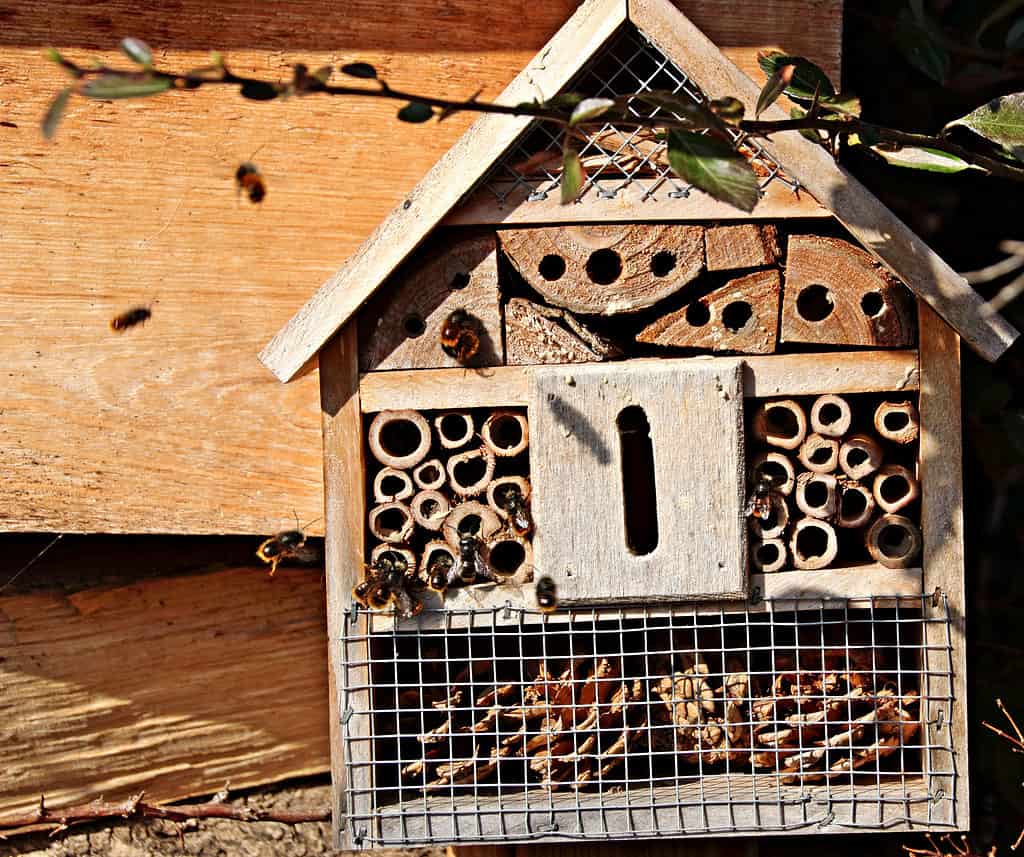
Buy or build your own bee hotel for the garden.
©iStock.com/Alexander Ließ
Bees don’t spend their entire lives flying around looking for pollen to bring back to their queens. They need rest, shelter, food, and water. So, providing them with some sheltering and nesting areas in your garden can help encourage bees to stick around a bit and further pollinate your garden or return frequently.
Bee hotels, for example, are a great way to provide shelter and nesting in one. You can find some easy DIY guides for building them or purchase some online. You should also consider providing some of the following for other types of bees:
- Open areas of soil for burrowing bees (both turned and unturned)
- Logs or thick branches for boring (carpenter) bees
- Compost piles or piles of dried grass
Tend Your Garden
Once you’ve built your bee garden, you’ll need to maintain the plants, of course, but because you’re caring for bees, as well, inadvertently, you’ll need to take some special care.
9. Water Your Garden Thoughtfully
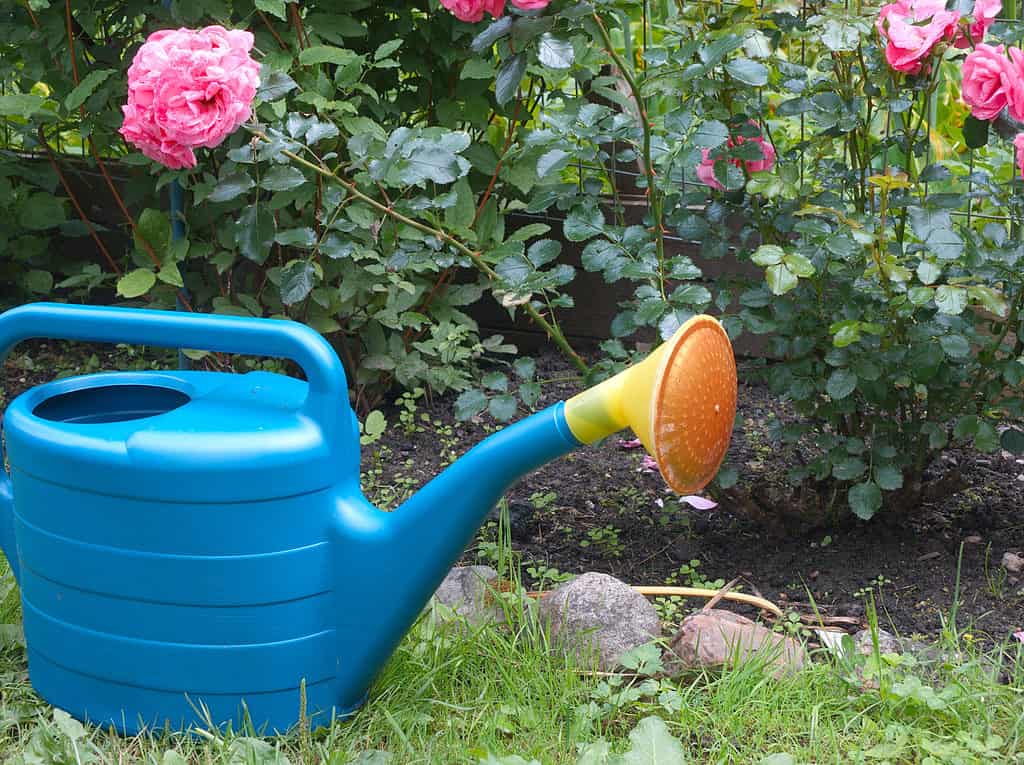
Consistent watering is required for plants to thrive.
©iStock.com/victorass88
As you water your garden, keep a few things in mind.
- Avoid wasting water. Skip the sprinklers, if possible, or at the very least put them on timers to help avoid as much wastage.
- Use organic compost instead of mulch to nourish your plants and slow water deprivation from run-off.
- Use a drip irrigation system, if possible, to keep the water where you want it.
- If you live in a particularly dry or arid area, consider creating a xeriscape bee garden.
- Use clean water to keep your plants happy and healthy.
- Ideally, collect rainwater and use that for your garden.
10. Try Composting

Compost is the healthiest option for your bee garden fertilization.
©Singkham/Shutterstock.com
If you have a little extra space, it’s highly recommended that you try composting. There are a few reasons for this.
- Organic compost is the best fertilizer for your bee garden.
- Organic compost is a safe place for bees to build nests.
- Vermicomposting is an intriguing and healthy way to have other useful insects help with some of the work around the garden.
11. Clean Up the Garden in Spring, Not Autumn
It may be tempting to deadhead and clean up the garden when autumn hits, but trimming off those flowers too soon could actually prevent your bee neighbors from thoroughly benefiting from your pollinator garden. And, in fact, many of these buzzing insects will bed down in the debris of plants in the garden or among the logs and tree trunks in there.
Allow some of those leaves to collect for some natural compost or gather the dead branches and decaying logs in one place where bees can nest in. Allow some bare earth to show through for burrower bees.
And when you do go to deal with that plant debris in spring, make sure you wait until temperatures are consistently in the 50s F to help make sure the population is healthy.
If you notice stems, branches, or others where bees have been nesting, gear up and move those to a separate place in the garden to allow the bees to emerge on their own when they’re ready.
Note: Skip the Mulch and Fabric
Finally, note that because many bee species nest in the ground, you should avoid using mulch or fabric to help keep nesting areas open for them.
The photo featured at the top of this post is © Gerrit Lammers/Shutterstock.com
Thank you for reading! Have some feedback for us? Contact the AZ Animals editorial team.






